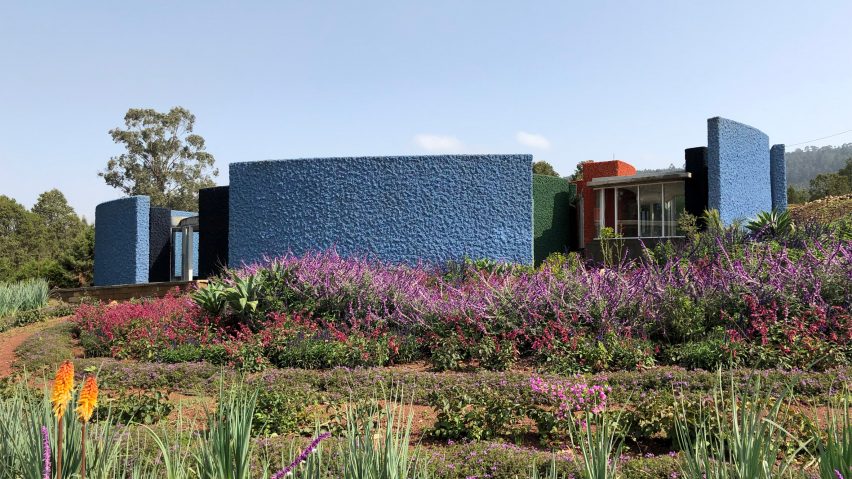Artist Olafur Eliasson and architect Sebastian Behmann's firm Studio Other Spaces has designed five buildings and seven pavilions within the Meles Zenawi Memorial Park in Addis Ababa, Ethiopia.
Created in memory of the country's former prime minister, the buildings in the 65-hectare park, located directly to the north of the city, were developed over a decade by Studio Other Spaces.
Described by the studio as an "anti-monument" they were built for the Meles Zenawi Foundation to commemorate the life of Meles Zenawi, who was the president of Ethiopia from 1991 to 1995 and then prime minister until his death in 2012.
"Meles Zenawi Memorial Park is not a singular form to be passively observed by onlookers, but rather an expansive, multifaceted landscape where visitors are invited to actively co-produce its purpose and meaning," explained the studio.
Within the park, which was designed in collaboration with landscape architecture studio Vogt, Studio Other Spaces created a series of round structures that contain an events space, guesthouse, office, research centre and library.
Alongside these buildings, seven round pavilions connected by a path that runs through the landscape were erected as spaces to explore and reflect.
"By designing a socially horizontal space, we have expanded the meaning of the word 'memorial' beyond the memory of a single leader to include the many memories of the countless people, whether from the cities or countryside, whether old or young, rich or poor, who make up the country of Ethiopia and who themselves have lived its history," said the studio.
"The hope is that the memorial park can accommodate the many, often complex feelings and reflections around Meles Zenawi's legacy, from celebration and optimism to grief and reckoning."
While sharing the same basic rounded form, each of the buildings has a different plan and utilises direct materials to create a varied visual appearance with the guesthouse, library and office set alongside each other.
The single-storey guesthouse has a central circular courtyard and is surrounded by colourful freestanding walls positioned in concentric rings.
Traditional plastering techniques adopted from the old city of Harar were used on the walls, which involved plastering many layers on top of each other to create a rough texture.
Near it, Studio Other Spaces designed the office building as a spiral, with a core spiral walkway and external walkway wrapping glazed workspaces and meeting rooms.
"The building's transparency and flowing sequence of spaces express the openness, introspection, and cooperation that drive the foundation's work," said the studio.
Completing the trio, the library building has a spiral form that expands towards the top, intended as a "gesture to the library's possible expansion and the constant growth potential of knowledge".
A spiral staircase with deep steps at the centre of the building provides a social space to sit and read, lit from above by an opening in the roof terrace.
"While the closed, solid exterior suggests the introverted nature of the building's use for reading and study, a patio at the upper end of the spiral provides an expansive panorama and space for outdoor recreation," explained Studio Other Spaces.
Set slightly below the guesthouse, library and office, the research centre contains five circular ground floor spaces, which contain four workspaces and a spiral staircase, that conjoin at first floor level to form the main research space.
It has a sculptural form decorated with stone-clad walls, which follow a gradient pattern of grey stones at the bottom of the walls changing to ochre-coloured stone at the top.
"The building's unorthodox design creates a striking presence within the landscape and, in a way comparable to how sculpture defines space, frames the public terraces cascading out from beneath it," said Studio Other Spaces.
Separate from the other buildings, the events space was created to host conferences and exhibitions.
Its curved concrete walls have a ribbed texture created by using bamboo formwork and it was topped with a rooftop terrace that has views across the city.
Connected by a trail, the seven pavilions were designed to represent stages of Meles Zenawi's personal and political life, based on the themes of education, debate, struggle, transition and constitution.
"Stretching along seven commemorative stations on the western side of the park, a memorial trail traces the childhood, education, and services of Meles Zenawi, aimed at representing the upbringing and political circumstances of his generation and what it could have meant to grow up in Ethiopia during this period," said Studio Other Spaces.
Now the Meles Zenawi Memorial Park is complete Studio Other Spaces are concerned that the landscape will not continue to be used as a community space as it was intended.
"The ongoing political upheaval in Ethiopia means there is no way to be sure if the park will fulfil its original vision as a cultural institution and peace project," said the studio.
"After a decade of collaboration and creation, it is possible that the project will fall into disuse, or will be repurposed altogether to serve other, less civic-minded interests," it continued.
"The hardware is all there, but what remains to be deployed is the software needed to activate the park – the community, minds, and scholarship that the project is intended for."
Founded in Berlin in 2014, the studio has completed a number of public spaces and design projects worldwide, including a conical glass pavilion for a Californian winery and an installation at the 2021 Venice Architecture Biennale displaying fungi and trees.
The photography is by Michael Tsegaye courtesy of Studio Other Spaces unless stated.
Project credits:
Design collaborators: Fasil Giorghis Architects and Kidus Hailesilassie
Contractor: Varnero
Stonework: Quartet Art Studio
Landscape design: Vogt

